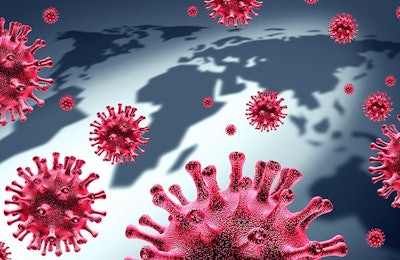
COVID-19 will likely significantly impact the global demand for chicken meat, the ability to staff operations and the food supply chain around the world.
As part of a WATT Global Media webinar sponsored by Boehringer Ingelheim presented on April 28, 2020, Gordon Butland, the director at G&S Agriconsultant Co. Ltd., shared his projections for how the global pandemic will shape the poultry market around the world.
Demand for chicken
The top concern is continuing demand for chicken around the world. In that case, he said, it’s a tale of two viruses: COVID-19 – a tremendous public health as well as political and social challenge for humanity – and African swine fever (ASF) – a disease that appeared in China in August 2018 which has since rocked that country’s swine industry and created a tremendous shortfall of animal protein.
It’s certain, Butland said, there will be upheaval in all global animal protein markets caused by COVID-19 but it will arrive in some areas sooner than others and hit some sectors harder than others, too.
Around the world, the expectation is economies will become depressed by the disease and lock down conditions. Historically, meat consumption is tied to income. As incomes rise, so does meat consumption. Therefore, Butland said, if incomes fall due to a prolonged financial downturn then there will be less demand for meat as consumers opt for cheaper meals.
That said, there is a feeling China’s massive deficit of animal protein will create enough demand to make up for shortfalls elsewhere around the world. But, he cautioned, the demand will not be great enough to solve everyone’s problems.
At the end of 2019, China and the U.S. reached an agreement to open the country back up to U.S. exports. Before then, Brazil was far and away the leader in exporting chicken to China. In the first quarter of 2020, according to the latest available statistics Brazil is still the leader by far but the U.S. is gaining a foothold in China.
Butland said the situation may be setting up for a price war – specifically between the U.S. and Brazil – on certain parts in China as many producers around the world increased their production with an expectation of finding a market in China.
Labor availability
The second disruptive factor will be the availability of labor. Already in the U.S., meat processors across species are being forced to close due a shortage of workers caused by COVID-19. At the end of April 2020, citing food supply chain security concerns, American processing plants were ordered to remain open.
Elsewhere around the world, the problem is emerging as well although it is not as pronounced just yet, Butland said. The other major exporting nations he observes, Thailand and Brazil, hadn’t seen any production stoppages yet.
Nevertheless, the problem is obvious and daunting. Social distancing is near impossible in a poultry plant and hundreds of workers are needed to process and pack the meat. In some parts of Asia, he said, workers even live on the grounds of the processing plant.
The only potential way to promote social distancing would be slowing the line speed which, of course, would lead to a notable reduction in processing capacity.
Supply chain logistics
The final disruption is likely the most mysterious and far reaching as COVID-19 may bring unexpected shortages and freeze or slow the transportation of goods between nations.
Butland shared an anecdote about how China’s dairy industry was shocked by the ASF crisis. Whey was a major ingredient in piglet feed, so when there was no more piglets to feed there was no demand for a key product.
So far, the world saw the price of oil suddenly collapse in March and April 2020 as well as the price of ethanol. Butland said other unforeseen consequences may emerge as the scenario plays out. Already, animal feed ingredients are in short supply in some parts of the world.
What everyone will need to do – even those in food-secure nations – is review their food supply chain. Quality control will become more difficult and more important, he said, especially because no one is certain how long the COVID-19 crisis and the ASF challenge will continue.

















